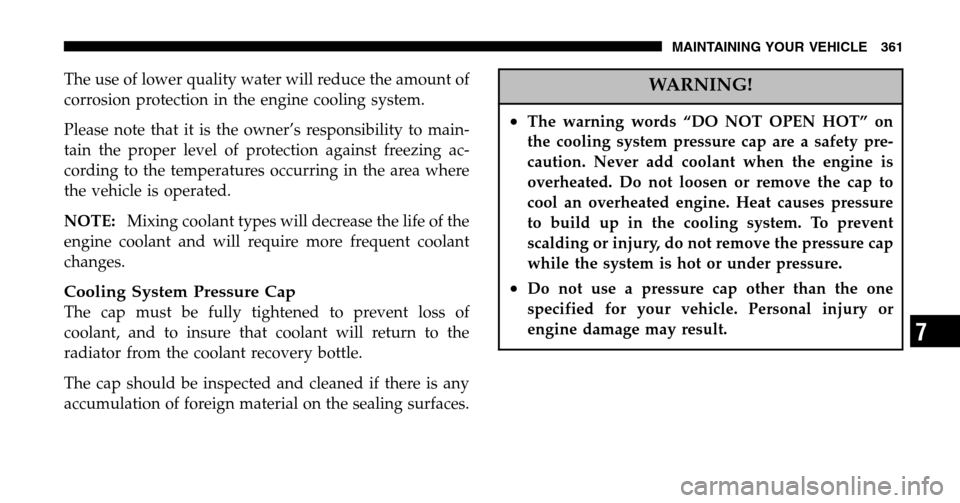2006 CHRYSLER PACIFICA radiator
[x] Cancel search: radiatorPage 361 of 440

The use of lower quality water will reduce the amount of
corrosion protection in the engine cooling system.
Please note that it is the owner’s responsibility to main-
tain the proper level of protection against freezing ac-
cording to the temperatures occurring in the area where
the vehicle is operated.
NOTE: Mixing coolant types will decrease the life of the
engine coolant and will require more frequent coolant
changes.
Cooling System Pressure Cap
The cap must be fully tightened to prevent loss of
coolant, and to insure that coolant will return to the
radiator from the coolant recovery bottle.
The cap should be inspected and cleaned if there is any
accumulation of foreign material on the sealing surfaces.
WARNING!
•The warning words “DO NOT OPEN HOT” on
the cooling system pressure cap are a safety pre-
caution. Never add coolant when the engine is
overheated. Do not loosen or remove the cap to
cool an overheated engine. Heat causes pressure
to build up in the cooling system. To prevent
scalding or injury, do not remove the pressure cap
while the system is hot or under pressure.
•Do not use a pressure cap other than the one
specified for your vehicle. Personal injury or
engine damage may result.
MAINTAINING YOUR VEHICLE 361
7
Page 362 of 440

Disposal of Used Engine Coolant
Used ethylene glycol based engine coolant is a regulated
substance requiring proper disposal. Check with your
local authorities to determine the disposal rules for your
community. To prevent ingestion by animals or children
do not store ethylene glycol based engine coolant in open
containers or allow it to remain in puddles on the
ground. If ingested by a child, contact a physician
immediately. Clean up any ground spills immediately.
Engine Coolant Level
The coolant bottle provides a quick visual method for
determining that the coolant level is adequate. With the
engine off and cold, the coolant level in the coolant
recovery bottle should be between the ranges indicated
on the bottle.
The radiator normally remains completely full, so there is
no need to remove the radiator cap unless checking for
coolant freeze point or replacing coolant. Advise your service attendant of this. As long as the engine operating
temperature is satisfactory, the coolant bottle need only
be checked once a month.
When additional coolant is needed to maintain the
proper level, it should be added to the coolant bottle. Do
not overfill.
Points To Remember
NOTE:
When the vehicle is stopped after a few miles (a
few kilometers) of operation, you may observe vapor
coming from the front of the engine compartment. This is
normally a result of moisture from rain, snow, or high
humidity accumulating on the radiator and being vapor-
ized when the thermostat opens, allowing hot coolant to
enter the radiator.
362 MAINTAINING YOUR VEHICLE
Page 363 of 440

If an examination of your engine compartment shows no
evidence of radiator or hose leaks, the vehicle may be
safely driven. The vapor will soon dissipate.
•Do not overfill the coolant recovery bottle.
•Check coolant freeze point in the radiator and in the
coolant recovery bottle. If antifreeze needs to be
added, contents of coolant recovery bottle must also be
protected against freezing.
•If frequent coolant additions are required, or if the
level in the coolant recovery bottle does not drop when
the engine cools, the cooling system should be pres-
sure tested for leaks.
•Maintain coolant concentration at 50% HOAT engine
coolant (minimum) and distilled water for proper
corrosion protection of your engine which contains
aluminum components.
•Make sure that the radiator and coolant recovery
bottle overflow hoses are not kinked or obstructed.
•Keep the front of the radiator clean. If your vehicle is
equipped with air conditioning, keep the front of the
condenser clean, also.
•Do not change the thermostat for summer or winter
operation. If replacement is ever necessary, install
ONLY the correct type thermostat. Other designs may
result in unsatisfactory coolant performance, poor gas
mileage, and increased emissions.
Hoses And Vacuum/Vapor Harnesses
Inspect surfaces of hoses and nylon tubing for evidence
of heat and mechanical damage. Hard or soft spots,
brittle rubber, cracking, tears, cuts, abrasions, and exces-
sive swelling indicate deterioration of the rubber.
MAINTAINING YOUR VEHICLE 363
7
Page 367 of 440

CAUTION!
Do not allow petroleum base fluid to contaminate
the brake fluid, all brake seal components could be
damaged causing partial or complete brake failure.
Fuel System Hoses
Electronic Fuel Injection high pressure fuel systems are
designed with hoses and quick connect fittings which
have unique material characteristics to provide adequate
sealing and resist attack by deteriorated gasoline.
You are urged to use only the manufacture specified
hoses with quick connect fittings, or their equivalent in
material and specification, in any fuel system servicing. It
is mandatory to replace any damaged hoses or quick
connect fittings that have been removed during service. Care should be taken in installing quick connect fittings
to insure they are properly installed and fully connected.
See your authorized dealer for service.
Automatic Transmission
The automatic transmission and differential assembly are
contained within a single housing.
All automatic transmissions are equipped with a conven-
tional filler tube and dipstick. If fluid is added, it should
be added through the dipstick hole in the case.
The dipstick is located just behind the radiator, lower
right side.
Selection of Lubricant
It is important that the proper lubricant is used in the
transmission to assure optimum transmission perfor-
mance. Use only manufacturers recommended transmis-
sion fluid, refer to Fluids, Lubricants and Genuine Parts
MAINTAINING YOUR VEHICLE 367
7
Page 378 of 440

Cavity Maxi Fuse Description
10 Spare
11 40 Amp Green Headlight Washer, Power
Liftgate
12 Spare
13 40 Amp Green Radiator Fan 1
14 Spare
15 40 Amp Green Anti-Lock Brake System
(ABS) Module
40 40 Amp Green Driver Door Node
41 40 Amp Green Passenger Door Node
42 40 Amp Green Front BlowerCavity Mini Fuse Description
24 20 Amp Yel- low Power Outlet (Selectable)
25 15 Amp Blue Radio, Amplifier, Naviga- tion, Hands-Free Phone
(HFM), Electronic Vehicle
Information Center (EVIC),
EC, SNRF, Mirror
26 20 Amp Yel- low Power Outlet
27 Spare
28 25 Amp Natural Horn
29 20 Amp Yel- low Cluster, CHMSL, Stop
Lights, Anti-Lock Brake
System (ABS)
30 10 Amp Red Ignition Switch
31 20 Amp Yel- low Hazard
378 MAINTAINING YOUR VEHICLE
Page 423 of 440

Selection Of Lubricant................367,388
Shifting ............................. 263
Special Additives ...................... 370
Automatic Transmission ................... 367
Adding Fluid ......................... 368
Fluid and Filter Changes ................. 369
Fluid Change ......................... 369
Fluid Level Check ...................... 368
Fluid Type ........................... 367
Autostick ........................... 139,264
Ball Joints ............................. 355
Battery ............................... 351
Gas Caution .......................... 352
Jump Starting ......................... 327
Keyless Transmitter Replacement (RKE) ....... 24
Bearings .............................. 372
Belts, Drive ............................ 348
Body Mechanism Lubrication ............... 356 B-Pillar Location
........................ 278
Brake, Parking .......................... 266
Brake System ........................ 268,364
Anti-Lock (ABS) ....................... 269
Fluid Check ....................... 365,388
Hoses .............................. 364
Warning Light ........................ 170
Brakes ............................. 268,364
Brake/Transmission Interlock ............... 261
Break-In Recommendations, New Vehicle ........ 71
Bulb Replacement ....................... 382
Bulbs, Light ............................ 381
Calibration, Compass ..................... 184
Capacities, Fluid ........................ 386
Caps, Filler Fuel ................................ 300
Oil (Engine) ....................... 346,347
Radiator (Coolant Pressure) ............... 361
INDEX 423
10
Page 425 of 440

Adding Coolant (Antifreeze).............. 360
Coolant Capacity ...................... 386
Coolant Level ...................... 359,362
Disposal of Used Coolant ................ 362
Drain, Flush, and Refill .................. 359
Inspection ........................... 362
Points to Remember .................... 362
Pressure Cap ......................... 361
Radiator Cap ......................... 361
Selection of Coolant (Antifreeze) ......359,386,387
Cruise Control (Speed Control) .............. 138
Cruise Light ........................... 173
Cup Holder ......................... 154,376
Customer Assistance ..................... 414
Dealer Service .......................... 343
Defroster, Rear Window ................... 253
Defroster, Windshield ................72,240,249
Delay (Intermittent) Wipers ................. 131 Diagnostic System, Onboard
................ 340
Dimmer Switch, Headlight ................. 130
Dipsticks Automatic Transmission ................. 368
Oil (Engine) .......................... 344
Disabled Vehicle Towing ................... 331
Disarming, Theft System ................... 26
Disposal Antifreeze (Engine Coolant) ............... 362
Engine Oil ........................... 348
Door Ajar Light ......................... 176
Door Locks ............................. 16
Door Locks, Automatic .................... 17
Door Opener, Garage ..................... 142
Drive Belts ............................ 348
Drive Shaft Universal Joints ................ 355
Driving On Slippery Surfaces .................... 329
INDEX 425
10
Page 433 of 440

Mirrors.............................. 82
Outlet (Auxiliary Electrical Outlet) .......... 152
Seats ............................ 106,107
Steering ............................. 271
Steering, Checking ..................... 354
Sunroof ............................. 149
Windows ............................. 32
Pregnant Women and Seat Belts .............. 44
Preparation for Jacking .................... 323
Pretensioners Seat Belts ............................. 42
Programmable Electronic Features ......144,147,179
Programming Transmitters
(Remote Keyless Entry) ...............23,144,147
Radial Ply Tires ......................... 285
Radiator Cap (Coolant Pressure Cap) .......359,361
Radio Broadcast Signals ................... 231
Radio Operation ...................... 207,233 Radio Remote Controls
.................216,229
Radio, Satellite .......................... 225
Radio (Sound Systems) ..............187,197,207
Rear Liftgate ............................ 28
Rear Seating Flexibility .................... 116
Rear Window Defroster ................... 253
Rear Window Features .................... 131
Rear Wiper/Washer ...................... 131
Rearview Mirrors ........................ 79
Reclining Front Seats ..................... 110
Recreational Towing ................... 315,332
Reminder, Seat Belt ....................... 43
Remote Control ......................... 216
Remote Keyless Entry (RKE) ................. 20
Remote Sound System (Radio) Controls ........ 229
Replacement Keys ........................ 14
Replacement Parts ....................... 343
Replacement Tires .................... 289,291
Reporting Safety Defects ................... 417
INDEX 433
10